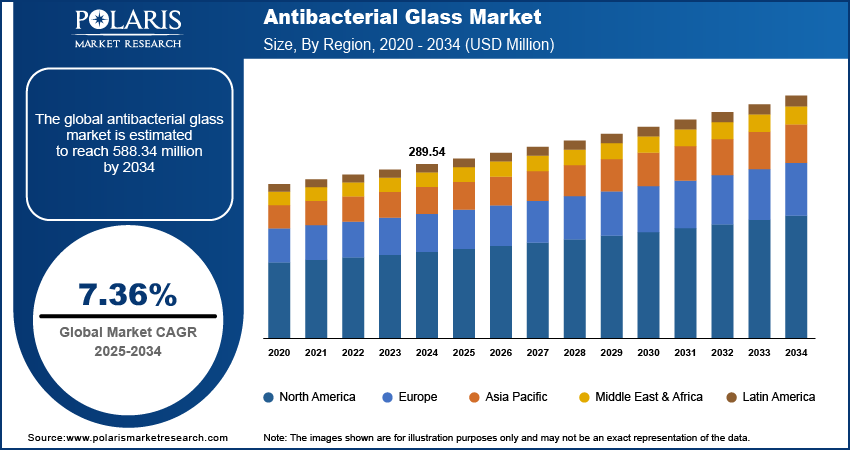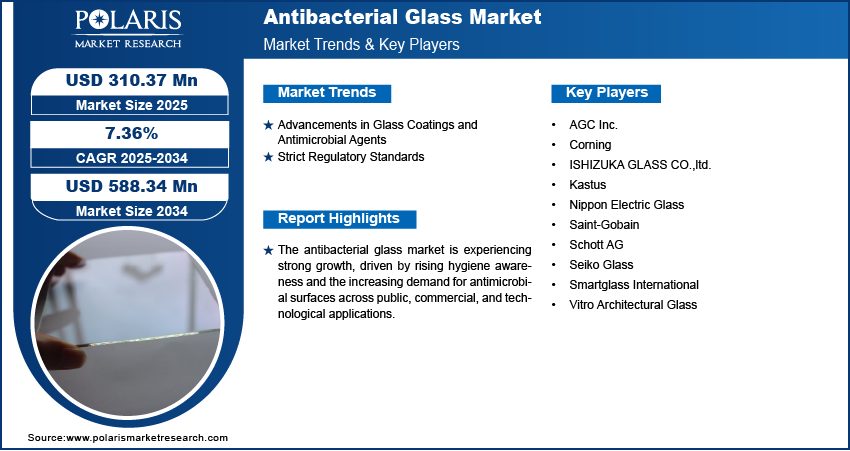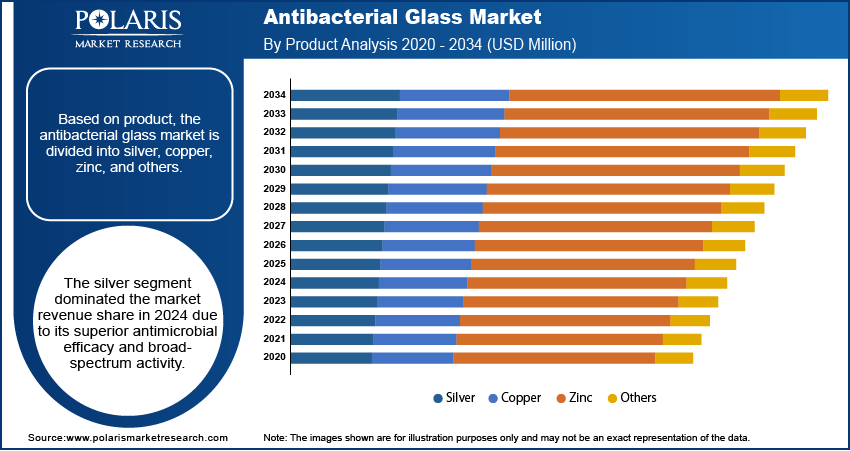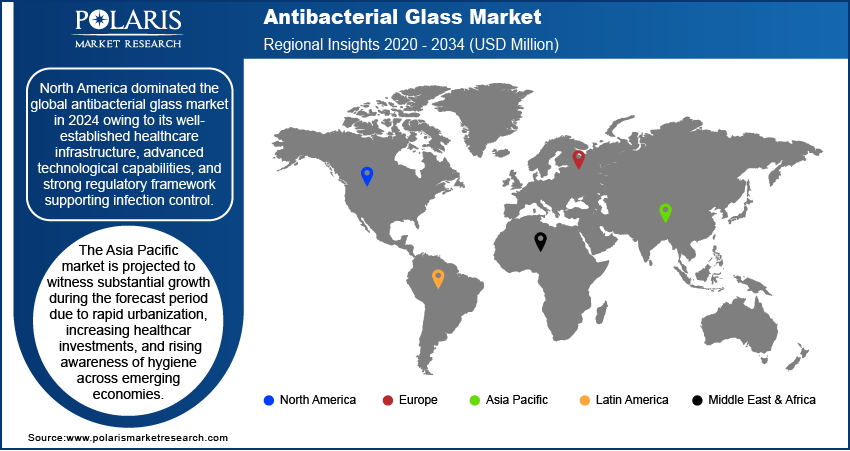
Antibacterial Glass Market Size, Share, & Industry Analysis Report
: By Product, By Glass Type (Silver, Copper, Zinc, and Others), By Application, and By Region – Market Forecast, 2025–2034
- Published Date:Jun-2025
- Pages: 129
- Format: pdf
- Report ID: PM5697
- Base Year: 2024
- Historical Data: 2020-2023
Market Overview
The global antibacterial glass market was valued at USD 289.54 million in 2024 and is expected to register a CAGR of 7.36% from 2025 to 2034. The growth is driven by the increased use of antibacterial glass in public spaces.
Antibacterial glass is a specially coated or treated glass designed to inhibit the growth and spread of bacteria on its surface. The antibacterial glass market is witnessing steady growth, driven significantly by increasing health awareness and the rising demand for infection control solutions across public and private environments. A May 2024 ECDC and EPA report stated that hospital-acquired infections (HAIs) affect 3.5 million patients annually in Europe and 1.7 million in the US, increasing demand for antimicrobial surfaces such as antibacterial glass in healthcare facility upgrades. The integration of antimicrobial coatings into frequently touched surfaces has become a priority as individuals and organizations become more conscious of hygiene, especially in the healthcare, food service, and hospitality sectors. Antibacterial glass serves as an effective solution for reducing microbial transmission in high-traffic areas such as hospitals, clinics, schools, and public transport systems, thereby supporting broader infection prevention initiatives. This heightened awareness reinforces the need for surfaces that meet structural and aesthetic standards and contribute actively to a healthier built environment.

To Understand More About this Research: Request a Free Sample Report
The expansion in consumer electronics is boosting the antibacterial glass market demand. With the addition of smartphones, tablets, touchscreen kiosks, and wearable devices, consumers are in frequent contact with electronic surfaces, making them potential breeding grounds for bacteria. These advanced antibacterial glass, integrated into commercial display panels and device interfaces, offers an added layer of hygiene without compromising touch sensitivity or visual clarity. Antibacterial glass is gaining traction as a preferred choice as device manufacturers prioritize user safety and differentiate their offerings through advanced materials. For instance, in July 2021, Newline Interactive developed an antimicrobial touchscreen coating effective against common pathogens such as E. coli and Staphylococcus. The technology addresses hygiene concerns in shared environments such as classrooms and offices where touchscreens are frequently used. This is further amplified by consumer preferences shifting toward more health-conscious product features, ultimately positioning antibacterial glass as a strategic component in the evolving electronics ecosystem.
Market Dynamics
Advancements in Glass Coatings and Antimicrobial Agents
Advancements in glass coatings and antimicrobial agents are driving growth opportunities by improving the performance and versatility of these materials. Continuous innovation in coating technologies has led to the development of more durable, transparent, and effective antimicrobial layers that can be seamlessly integrated into various glass products without compromising optical quality. For instance, in May 2024, LG Electronics launched LG PuroTec, an antimicrobial glass powder with anti-fungal and antibacterial properties. The material integrates with plastics, paint, and rubber while maintaining thermal stability and durability for diverse applications. These coatings now offer longer-lasting protection against a broader spectrum of pathogens, making them suitable for a wide range of applications, from healthcare infrastructure to consumer-facing products.
Progress in nanotechnology and bioactive materials has allowed more efficient bacterial resistance mechanisms, contributing to the wider acceptance and adoption of antibacterial glass. This technological evolution improves product efficacy and supports manufacturers in meeting growing customer expectations for hygiene and safety.
Strict Regulatory Standards
Regulatory bodies across various sectors, particularly in healthcare, food processing, and public infrastructure, are increasingly mandating the use of materials that reduce microbial contamination. The 2022 FDA Food Code mandated non-porous, easily cleanable surfaces in food-prep areas, driving demand for antimicrobial materials. These strict requirements are compelling manufacturers and end users to adopt certified and compliant solutions such as antibacterial glass, which aligns with health and safety protocols. Additionally, compliance with such standards enhances brand credibility and reduces liability risks, encouraging investments in advanced antimicrobial materials. They are reinforcing the demand for high-performance, tested, and reliable antibacterial glass solutions across multiple industries as these regulatory frameworks continue to evolve. Strict regulatory standards concerning hygiene, safety, and environmental impact are boosting the market growth.

Segment Insights
Market Assessment by Product
The global antibacterial glass market segmentation, based on product, includes silver, copper, zinc, and others. The silver segment dominated the market revenue share in 2024 due to its superior antimicrobial efficacy and broad-spectrum activity. Silver ions are highly effective in disrupting bacterial cell membranes and slowing microbial growth, making them a preferred choice for long-lasting protection. In addition, silver-based coatings are widely recognized for their stability, durability, and compatibility with various glass substrates. These properties make silver an ideal material for high-traffic environments such as healthcare, public infrastructure, and food processing facilities where hygiene is critical. The regulatory acceptance and proven performance of silver-based antibacterial solutions have further supported its widespread adoption, securing its leading position in the market.
Market Evaluation by Application
The global antibacterial glass market segmentation, based on application, includes hospitals, military, residential, food & beverage, and others. The military segment is expected to witness fastest growth during the forecast period, driven by an increasing focus on hygiene and contamination control in defense facilities and equipment. Military personnel often operate in confined or high-contact environments where the risk of infection transmission is advanced. Antibacterial glass is integrated into vehicles, mobile medical units, command centers, and training facilities to improve sanitation and operational safety. Moreover, the defense sector is known for its proactive adoption of advanced materials to improve soldier health and mission readiness, making it an adopter of innovative antimicrobial technologies. This focus on safeguarding personnel health under various harsh conditions is projected to accelerate the demand for antibacterial glass in military applications.

Regional Analysis
By region, the report provides the insights into North America, Europe, Asia Pacific, Latin America, and the Middle East & Africa. The North America antibacterial glass market dominated across the world in 2024 owing to its well-established healthcare infrastructure, advanced technological capabilities, and strong regulatory framework supporting infection control. The region’s early adoption of antimicrobial technologies across hospitals, laboratories, and commercial buildings has driven sustained demand for antibacterial glass. Moreover, high awareness levels regarding hygiene, coupled with strict sanitation standards, have compelled public and private entities to invest in improved surface protection solutions. The presence of key industry players and ongoing research and development in material science further contribute to North America’s leadership in the market, solidifying its position as a mature and innovation-driven region.

The Asia Pacific antibacterial glass industry is projected to witness substantial growth during the forecast period due to rapid urbanization, increasing healthcare investments, and rising awareness of hygiene across emerging economies. According to an IBEF March 2025 report, India's healthcare and pharmaceutical sector received USD 30 million in investments from 2022 to 2024. Countries in this region are expanding their medical and public infrastructure, prompting demand for materials that improve safety and cleanliness. Additionally, the growing consumer electronics market and rising middle-class population are accelerating the need for hygienic, touch-based interfaces, supporting the adoption of antibacterial glass. Government initiatives focused on improving public health standards and the proliferation of smart city projects are also expected to fuel the regional growth. As a result, Asia Pacific is emerging as a key growth frontier for antibacterial glass manufacturers.
Key Players and Competitive Analysis
The antibacterial glass sector is experiencing robust growth, driven by technological advancements in silver-ion coatings and photocatalytic solutions. Industry trends reveal rising demand in developed markets such as North America and Europe, where healthcare infrastructure and high-touch surface applications prioritize hygiene. Competitive analysis highlights strategic investments by leaders such as AGC Inc. and Saint-Gobain in sustainable value chains, targeting hospitals and public spaces. Meanwhile, emerging markets in Asia Pacific present expansion opportunities due to urbanization and increasing health awareness, though economic and geopolitical shifts may impact localization strategies. Disruptions and trends, such as nano-coating innovations and IoT-integrated smart glass, are reshaping revenue growth potential. Small and medium-sized businesses such as Kastus are leveraging niche business segments (e.g., consumer electronics), while larger firms focus on strategic alliances to improve regional footprints.
Expert insights emphasize that competitive positioning hinges on balancing cost efficiency with antimicrobial efficacy, particularly amid supply chain disruptions in raw materials. A few of the key players in the market are AGC Inc.; Corning; ISHIZUKA GLASS CO., Ltd.; Kastus; Nippon Electric Glass; Saint-Gobain; Schott AG; Seiko Glass; Smartglass International; and Vitro Architectural Glass.
AGC Inc. operates in the field of glass manufacturing and innovation. Its antibacterial glass represents an advancement in hygiene-focused architectural materials. Branded as Antibacterial glass, AGC’s solution is engineered using a patented process that diffuses silver ions into the upper layers of the glass. These silver ions interact with bacteria on the surface, disrupting their metabolism and division and effectively eliminating 99% of bacteria, including common pathogens such as Staphylococcus aureus, Escherichia coli, and Pseudomonas aeruginosa, as well as preventing the spread of fungi. This antimicrobial effect is continuous and particularly effective in warm and moist environments where bacteria and mold are prone to develop. AGC’s antibacterial glass range includes products such as PLANIBEL AB (clear glass), LACOBEL AB (painted glass), MIROX AB (mirrors), STRATOBEL AB (laminated glass), and STRATOPHONE AB (acoustic laminated glass), all stamped with a special AB certification mark. These products are designed for a wide array of interior applications where hygiene is critical, such as hospitals, clinics, laboratories, rest homes, bathrooms, and other damp or high-traffic public spaces. The glass is easy to clean, resistant to hospital-grade cleaning agents, and maintains its antibacterial properties even after repeated cleaning. AGC’s antibacterial glass is a preferred solution for environments demanding strict infection control and modern design with its contemporary aesthetics and robust, hygienic performance.
Nippon Electric Glass (NEG) is a Japanese manufacturer specializing in advanced glass materials, such as innovative antibacterial glass solutions. NEG’s antibacterial glass technology is centered on its proprietary antibacterial glass powders, notably the ZF-0 and DL-7900 series, which use zinc as their main component. These powders are engineered to exhibit high antibacterial properties, with DL-7900 demonstrating even greater antibacterial capacity than traditional silver-based antibacterial glass, allowing for lower usage rates while maintaining effectiveness. The antibacterial action targets common pathogens such as Escherichia coli and Staphylococcus aureus, making the material suitable for environments where hygiene is critical. NEG’s antibacterial glass powders are designed for integration into various products, such as household appliances and plumbing supplies. The powders maintain their antibacterial persistence and resist discoloration, even under prolonged exposure to moisture and heat, ensuring long-term efficacy and durability. Nippon Electric Glass supports manufacturers in creating products that help inhibit bacterial growth, contributing to safer, more hygienic living and working environments by offering these advanced materials. This technological approach positions NEG as a player in the antibacterial glass market, particularly for applications demanding strict hygiene standards.
List of Key Companies in Antibacterial Glass Market
- AGC Inc.
- Corning
- ISHIZUKA GLASS CO., ltd.
- Kastus
- Nippon Electric Glass
- Saint-Gobain
- Schott AG
- Seiko Glass
- Smartglass International
- Vitro Architectural Glass
Antibacterial Glass Industry Development
January 2025: AGC Glass Europe expanded its operations by acquiring Sicherheitsglastechnik Oelsnitz GmbH (SGT), one of Europe's leading safety glass manufacturers, along with Verwaltungsgesellschaft Schuler & Weiß OHG and its subsidiary SG Transport GmbH in Germany.
Antibacterial Glass Market Segmentation
By Product Outlook (Revenue, USD Million, 2020–2034)
- Silver
- Copper
- Zinc
- Others
By Glass Type Outlook (Revenue, USD Million, 2020–2034)
- Clear Glass
- Painted Glass
- Laminated Glass
- Acoustic Laminated Glass
- Others
By Application Outlook (Revenue, USD Million, 2020–2034)
- Hospitals
- Military
- Residential
- Food & Beverage
- Others
By Regional Outlook (Revenue, USD Million, 2020–2034)
- North America
- US
- Canada
- Europe
- Germany
- France
- UK
- Italy
- Spain
- Netherlands
- Russia
- Rest of Europe
- Asia Pacific
- China
- Japan
- India
- Malaysia
- South Korea
- Indonesia
- Australia
- Vietnam
- Rest of Asia Pacific
- Middle East & Africa
- Saudi Arabia
- UAE
- Israel
- South Africa
- Rest of Middle East & Africa
- Latin America
- Mexico
- Brazil
- Argentina
- Rest of Latin America
Antibacterial Glass Market Report Scope
|
Report Attributes |
Details |
|
Market Size Value in 2024 |
USD 289.54 million |
|
Market Size Value in 2025 |
USD 310.37 million |
|
Revenue Forecast by 2034 |
USD 588.34 million |
|
CAGR |
7.36% from 2025 to 2034 |
|
Base Year |
2024 |
|
Historical Data |
2020–2023 |
|
Forecast Period |
2025–2034 |
|
Quantitative Units |
Revenue in USD Million and CAGR from 2025 to 2034 |
|
Report Coverage |
Revenue Forecast, Competitive Landscape, Growth Factors, and Industry Trends |
|
Segments Covered |
|
|
Regional Scope |
|
|
Competitive Landscape |
|
|
Report Format |
|
|
Customization |
Report customization as per your requirements with respect to countries, regions, and segmentation. |
FAQ's
The global market size was valued at USD 289.54 million in 2024 and is projected to grow to USD 588.34 million by 2034.
The global market is projected to register a CAGR of 7.36% during the forecast period.
North America dominated the market share in 2024.
A few of the key players in the market are AGC Inc.; Corning; ISHIZUKA GLASS CO., Ltd.; Kastus; Nippon Electric Glass; Saint-Gobain; Schott AG; Seiko Glass; Smartglass International; and Vitro Architectural Glass.
The silver segment dominated the market revenue share in 2024
The military segment is expected to witness fastest growth during the forecast period.
